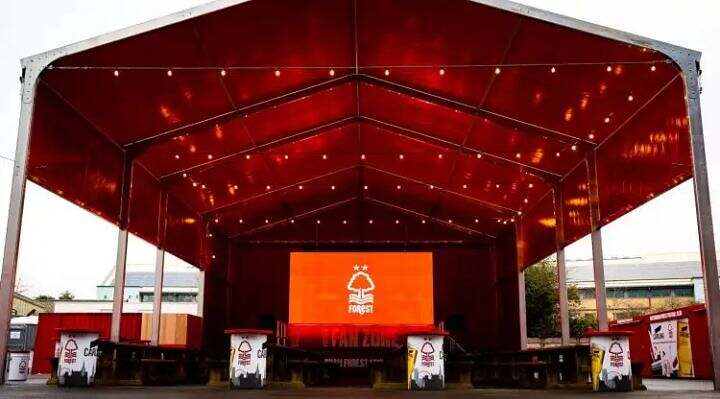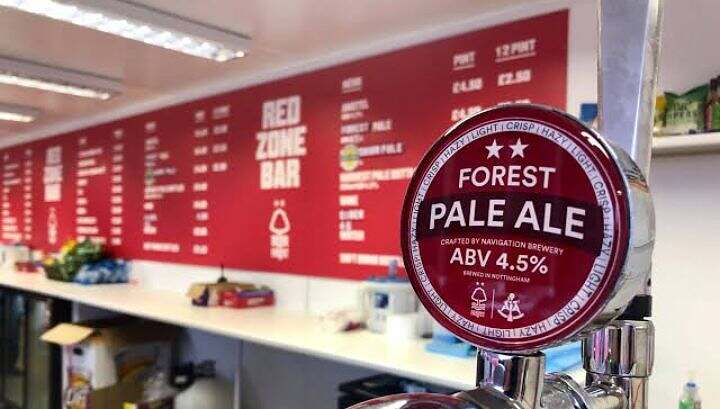Nottingham Forest’s new Fan Zone is pure brilliance — it actually creates its own energy

From Brian Clough’s unwavering spirit, which led the team to consecutive European Cups, to more recent developments off the pitch, which modernised the matchday experience, Nottingham Forest has never shied away from innovation.
One of the club’s most audacious initiatives to date was the creation of a carbon-zero, energy-generating Fan Zone at The City Ground in December 2023.
This initiative was the result of a sustainable cooperation with energy provider E.ON. This serves as a statement as well as a space for supporters to congregate before kickoff: Forest seems committed to make football more environmentally friendly.
On December 2, 2023, the Fan Zone formally opened in time for a home game against Everton. It can accommodate up to 1,000 fans at once and is located at the City Ground behind the Brian Clough Stand.
At its centre is a foldable solar canopy that covers the main stage and houses seating and a huge screen. In addition to keeping the rain off, this solar roof can produce and store about 12,000 kWh of energy annually.
The Fan Zone need more than that to function. There is a real environmental benefit. According to estimates, the initiative will reduce CO2 emissions by roughly 2,472 kg per year.
Trending
There are other green features outside the solar cover. Repurposed containers to house street food sellers, bars serving drinks in recyclable cups, biodiversity planting, recycled timber fencing, planters, and a battery storage facility to store energy harvested during sunny times for later use.
A fan zone’s atmosphere—music, food, and community—is what many find appealing. That’s exactly what Forest’s new Fan Zone offers, but with a sustainable twist.
It is open before and after home games, allowing supporters to experience the excitement before and after the game.

Drinks are supplied in reusable cups, local vendors operate in repurposed containers rather than brand-new ones, and biodiversity-promoting landscaping and plantings make the area more aesthetically pleasing and environmentally friendly.
It’s an attempt to demonstrate that responsible design can coexist with matchday customs like food, singing, and togetherness.
“How do we entertain our fans?” and “how do we do that without costing the planet?” appear to be the two main objectives.
Forest’s initiative comes at a time when sustainability is seen as more than just public relations in English football; it is now seen to be crucial.
The energy consumption, waste, travel, and carbon footprint of stadiums, fan areas, and club operations are being closely examined.
Forest is going beyond small fixes (more recycling bins, fewer plastic) by transforming its Fan Zone into a net source of electricity, a move that reimagines the game-day area.
According to Tom Cartledge, the club’s chairman at the time, the Fan Zone is “just the first of many projects to help realise a truly fan-focused and sustainable future for our club.”
In addition to aiming for “net zero” emissions, Forest’s larger sustainability cooperation with E.ON also includes investigating further sustainable projects at the training facility and stadium.
Although 12,000 kWh is noteworthy, particularly since it exceeds the Fan Zone’s own usage, it is still a small part of a larger stadium or club with other amenities. Of course, the Fan Zone is not a perfect utopia.
The approximately 2.5 tonnes of CO₂ saved is welcome, matchday travel, stadium heating, lighting, enormous crowds, and other activities provide Forest (and other Premier League clubs) with their biggest environmental issue.
There will be real-world difficulties as well. How does this function on matchdays with cloudy skies or in the winter when there is little daylight? Although storage is useful, battery technology is not flawless.
It’s critical to maintain solar infrastructure, make sure nearby suppliers and establishments follow sustainability guidelines, and maintain practices (such as using reusable cups and segregating garbage) that complement the equipment.
The ways that Forest hopes to use the Fan Zone as a platform to educate supporters about energy, promote sustainable practices at home, and incorporate environmental responsibility into the club’s fan interaction are also significant.
For instance, Forest eliminated single-use plastics (straws, cups and cutlery), encouraged fans to take public transit by offering discounts and, for a limited time, had zero trash going to landfills.
In the future, Forest might recreate or grow these types of sustainable fan areas. The same model may be used for future stands, concessions, or community facilities: solar (or other renewables), recyclables, knowledge of carbon impact, and infrastructure that contributes rather than just consumes.
More than merely a new idea, The City Ground’s energy-generating Fan Zone is a show of ecological ambition. Football’s environmental problems cannot be resolved by a single initiative, and forests are not flawless.
However, Forest has demonstrated that “green” can coexist with tradition, atmosphere, and enthusiasm by making investments in infrastructure that actively generates and stores renewable energy, creating fan-centric yet environmentally conscious environments, and incorporating sustainability into the matchday ritual.
It’s a worthy homage to Cloughie’s well-known jumper, which is iconic, daring, and demonstrates how even the most venerable organisations can surprise you.
And Forest might be setting the standard for clubs around the nation to be as green as Old Big ‘Ed’s knits if the sunny (or at least cloudless) days ahead are accompanied by other such actions.






